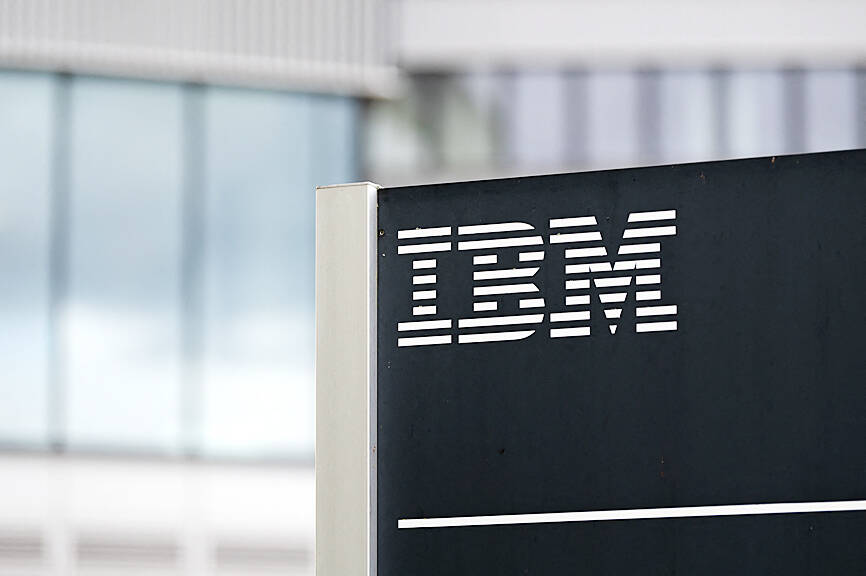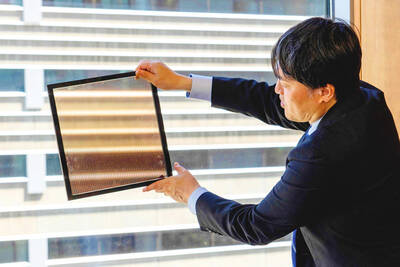Technology giant IBM Corp announced plans yesterday to invest US$150 billion in the US over five years, including US$30 billion earmarked for research and development to bolster manufacturing of mainframe and quantum computers.
"Technology doesn’t just build the future — it defines it," IBM chairman and CEO Arvind Krishna said in a statement.
The investment, which comes as US President Donald Trump puts pressure on companies to invest in the United States, aims to cement IBM’s position as "the epicenter of the world’s most advanced computing and AI capabilities," Krishna added.

Photo: Silas Stein, AFP
Over the past five years, IBM reported about US$33.6 billion in research and development spending globally. Its total operational expenses in that time frame were US$141.8 billion.
Corporate giants, including Apple Inc, Nvidia Corp and Hyundai Motor Co, have announced major spending plans in the US since Trump returned to the White House in January, though some of that investment was already in the pipeline.
Trump earlier this month unveiled an unprecedented wave of tariff hikes in his effort to push US companies to shift manufacturing home.
The US president has since put most of the tariffs on hold, as worries grow about their severe impact on the US economy, though massive levies remain on China.
IBM stressed in its statement its "unwavering commitment to the future of American innovation, igniting new economic opportunity in the United States and around the world."
The 114-year-old company — which has trailed the dominant players Microsoft Corp, Amazon.com Inc and Google in recent years — emphasized that it operates the world’s largest fleet of quantum computing systems, which is seen as technology’s next frontier.

UNCERTAINTIES: Exports surged 34.1% and private investment grew 7.03% to outpace expectations in the first half, although US tariffs could stall momentum The Chung-Hua Institution for Economic Research (CIER, 中華經濟研究院) yesterday raised its GDP growth forecast to 3.05 percent this year on a robust first-half performance, but warned that US tariff threats and external uncertainty could stall momentum in the second half of the year. “The first half proved exceptionally strong, allowing room for optimism,” CIER president Lien Hsien-ming (連賢明) said. “But the growth momentum may slow moving forward due to US tariffs.” The tariff threat poses definite downside risks, although the scale of the impact remains unclear given the unpredictability of US President Donald Trump’s policies, Lien said. Despite the headwinds, Taiwan is likely

When Lika Megreladze was a child, life in her native western Georgian region of Guria revolved around tea. Her mother worked for decades as a scientist at the Soviet Union’s Institute of Tea and Subtropical Crops in the village of Anaseuli, Georgia, perfecting cultivation methods for a Georgian tea industry that supplied the bulk of the vast communist state’s brews. “When I was a child, this was only my mum’s workplace. Only later I realized that it was something big,” she said. Now, the institute lies abandoned. Yellowed papers are strewn around its decaying corridors, and a statue of Soviet founder Vladimir Lenin

UNIFYING OPPOSITION: Numerous companies have registered complaints over the potential levies, bringing together rival automakers in voicing their reservations US President Donald Trump is readying plans for industry-specific tariffs to kick in alongside his country-by-country duties in two weeks, ramping up his push to reshape the US’ standing in the global trading system by penalizing purchases from abroad. Administration officials could release details of Trump’s planned 50 percent duty on copper in the days before they are set to take effect on Friday next week, a person familiar with the matter said. That is the same date Trump’s “reciprocal” levies on products from more than 100 nations are slated to begin. Trump on Tuesday said that he is likely to impose tariffs

Japan is heavily investing in a new kind of ultra-thin, flexible solar panel that it hopes will help it meet renewable energy goals while challenging China’s dominance of the sector. Pliable perovskite panels are perfect for mountainous Japan, with its shortage of flat plots for traditional solar farms. A key component of the panels is iodine, something Japan produces more of than any country but Chile. The push faces some obstacles: Perovskite panels contain toxic lead, and, for now, produce less power and have shorter lifespans than their silicon counterparts. Still, with a goal of net zero by 2050 and a desire to